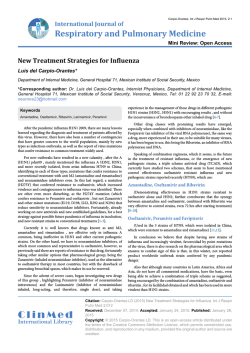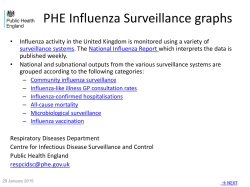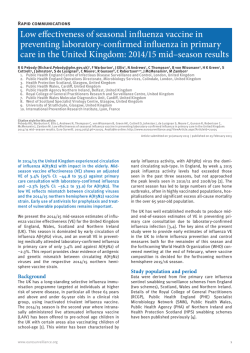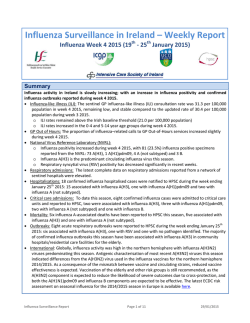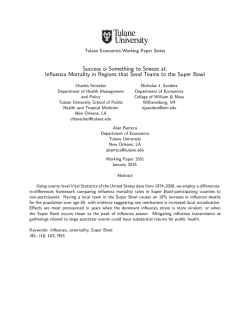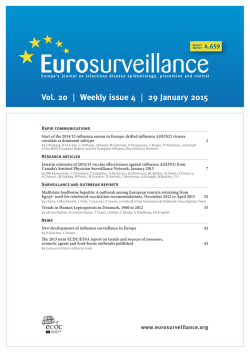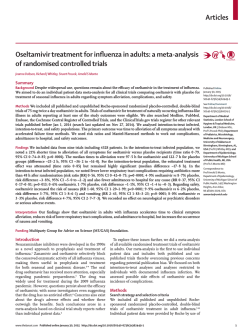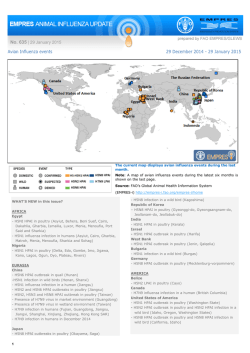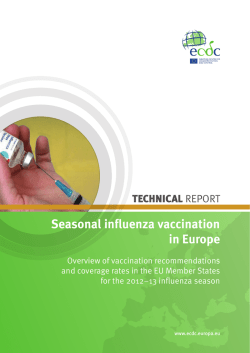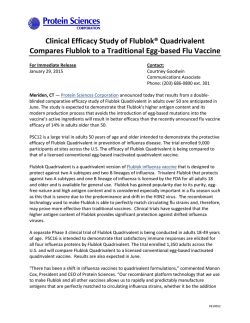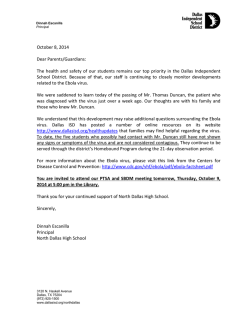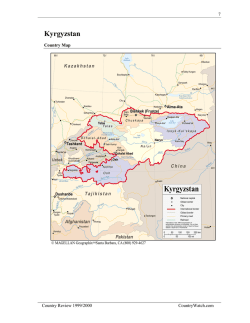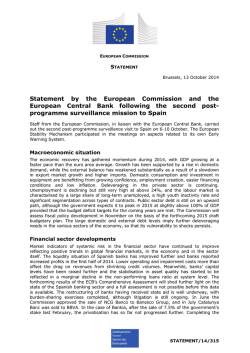
Influenza Update N° 222 - World Health Organization
Influenza Update N° 222 20 October 2014 Summary Globally, influenza activity remained low, with the exception of some tropical countries in the Americas and some Pacific Islands. In Europe and North America, overall influenza activity remained at inter-seasonal levels. In tropical countries of the Americas, influenza B co-circulated with respiratory syncytial virus (RSV). In Africa and western Asia, influenza activity was low. In eastern Asia, influenza activity in most countries remained low or decreased after some influenza A(H3N2) activity in August and September. In tropical Asia, influenza activity continued to decrease or remain low with influenza A(H3N2) predominant. In the southern hemisphere, influenza activity decreased in general except in several Pacific Islands where ILI activity remained high. In the temperate zone of South America, influenzalike illness (ILI) decreased and continued to be associated with RSV. Influenza A(H3N2) virus was the most frequently detected influenza virus. In Australia and New Zealand Influenza activity also decreased. The WHO recommendation on the composition of influenza vaccines for the southern hemisphere 2015 was announced on 25 Sept. The recommendation and associated technical report are posted at the WHO website: http://www.who.int/influenza/vaccines/virus/recommendations/2015_south/en/ Based on FluNet reporting (as of 16 October 2014 16:05 UTC), during weeks 39 to 40 (21 September 2014 to 4 October 2014), National Influenza Centres (NICs) and other national influenza laboratories from 53 countries, areas or territories reported data. The WHO GISRS laboratories tested more than 34 991 specimens. 1465 were positive for influenza viruses, of which 1001 (68.3%) were typed as influenza A and 464 (31.7%) as influenza B. Of the subtyped influenza A viruses, 96 (12.9%) were influenza A(H1N1)pdm09, 649 (87%) were influenza A(H3N2) and 1 (0.1%) was influenza A(H5). Of the characterized B viruses, 99 (99%) belonged to the B-Yamagata lineage and 1 (1%) to the B-Victoria lineage. Due to changes in data collection platforms, data from the WHO Regional Office for Europe are temporarily not available at global level. Those data will be uploaded to FluNet and FluID as soon as possible. Information on European influenza activity can be found at http://www.flunewseurope.org/ Influenza update | 20 October 2014 1 Note: Global epidemiology and surveillance updates are periodically collected from data reported by National authorities or organizations responsible for reporting this data. For further information on specific influenza virus activity in the world and scientific literature for practitioners and other professionals in the field, please visit the links provided at the end of this document. Countries in the temperate zone of the northern hemisphere North America, Europe, Northern Africa and the Western and Central Asia region In the countries in the northern hemisphere, overall influenza activity was at inter-seasonal levels. In the United States, influenza activity increased slightly but was still within expected levels for this time of year. In Europe, influenza activity was low with some sporadic detections of influenza virus in Spain and the United Kingdom. From 17 countries in the European region, 1% of 221 specimens tested positive for influenza. Eastern Asia In the eastern Asian region, influenza activity remained low with influenza A(H3N2) as the main virus in circulation. In northern China, influenza activity was low and mainly due to influenza A(H1N1)pdm09. In Japan and the Republic of Korea, influenza activity remained at inter-seasonal levels. In Mongolia, ILI activity increased with no indication of influenza activity. Influenza update | 20 October 2014 2 Number of specimens positive for influenza by subtype in the North Hemisphere Data source: FluNet (www.who.int/flunet). Global Influenza Surveillance and Response System (GISRS) Data generated on 16/10/14 Countries in the tropical zone Tropical countries of the Americas/Central America and the Caribbean Overall in this region, influenza activity was variable. Circulation of influenza B virus was reported from most of the Caribbean and central American countries, such as Costa Rica and Nicaragua. However, in most central American countries, circulation of influenza B virus has decreased over the recent weeks. In Cuba, influenza B also predominated among influenza detections, and severe acute respiratory infection (SARI) associated hospitalizations remained high due mainly to respiratory syncytial virus (RSV) In Nicaragua, influenza A(H3) was the predominant influenza virus subtype following an earlier wave of influenza B in August. Tropical countries in South America reported influenza-like illness (ILI) and SARI activity within the expected range for this time of the year. RSV continued to circulate but with decreasing trends. In the Plurinational State of Bolivia, influenza A(H1N1)pmd09 was the most frequently detected respiratory virus, and activity remained low. In Colombia, influenza activity continued, with influenza A(H3N2) predominating. Peru also experienced ongoing influenza with co-circulation of influenza A(H1N1)pdm09, A(H3N2) and B; however, influenza activity decreased and was lower compared to last year. In Brazil, activity continued with co-circulation of influenza A(H3N2) and influenza B viruses. Influenza activity was predominantly reported from the southeastern region where influenza A(H3N2) was most commonly detected virus. Influenza update | 20 October 2014 3 Number of specimens positive for influenza by subtype in the Tropical South America Data source: FluNet (www.who.int/flunet). Global Influenza Surveillance and Response System (GISRS) Data generated on 16/10/14 Central African tropical region In Africa, influenza activity reported from most countries in eastern, middle and western Africa was at low levels. Number of specimens positive for influenza by subtype in the African region Data source: FluNet (www.who.int/flunet). Global Influenza Surveillance and Response System (GISRS) Data generated on 16/10/2014 Influenza update | 20 October 2014 4 Tropical Asia In most southern Asian and South-Eastern Asian countries, activity declined or remained low. In India and Nepal, activity decreased after earlier peaks caused primarily by influenza A(H3N2) viruses and some influenza B virus detections. In southern China, ILI consultations increased slightly but the percent of specimens testing positive for influenza decreased. Influenza activity in south China was predominantly due to influenza A(H3N2) virus. The Lao People’s Democratic Republic and Thailand reported low influenza activity predominated by influenza B viruses, but Thailand reported high RSV activity with over 40% of specimens testing positive for RSV. Countries in the temperate zone of the southern hemisphere Temperate Zone of South America In the temperate zone of South America, influenza activity continued to decrease. In Chile and Argentina, ILI activity continued to decrease, corresponding with a decrease RSV. Influenza detections also decreased, with co-circulation of influenza A and B. In Paraguay, the ILI consultation rate decreased but remained at high levels compared to previous years, and the proportion of samples testing positive for influenza decreased. SARI notifications and influenza activity both decreased in Uruguay. Number of specimens positive for influenza by subtype in the temperate South America influenza transmission zone Data source: FluNet (www.who.int/flunet). Global Influenza Surveillance and Response System (GISRS) Data generated on 16/10/2014 Influenza update | 20 October 2014 5 South Africa In South Africa, ILI and SARI activity remained low, with influenza B predominating among positive ILI samples and co-circulating with influenza A(H3N2) virus. Oceania, Melanesia and Polynesia In Australia and New Zealand, influenza activity decreased, with co-circulation of influenza A(H1N1)pdm09, A(H3N2) and some influenza B. In Australia, ILI activity and the notification of laboratory confirmed cases decreased significantly across all jurisdictions. In New Zealand, the ILI consultation rate remained below the seasonal threshold and dropped below the average epidemic curve. In the Pacific Islands, ILI activity was variable; notifications were above 90% of historical values in the Federated States of Micronesia, Guam, New Caledonia, Northern Mariana Islands, Solomon Islands, and Tokelau. Number of specimens positive for influenza by subtype in Oceania, Melanesia and Polynesia Data source: FluNet (www.who.int/flunet). Global Influenza Surveillance and Response System (GISRS) Data generated on 16/10/2014 Source of data The Global Influenza Programme monitors influenza activity worldwide and publishes an update every two weeks. The updates are based on available epidemiological and virological data sources, including FluNet (reported by the WHO Global Influenza Surveillance and Response System) and influenza reports from WHO Regional Offices and Member States. Completeness can vary among updates due to availability and quality of data available at the time when the update is developed. Influenza update | 20 October 2014 6 Link to web pages Influenza reports from WHO Regional Offices: AMRO: http://www.paho.org/hq/index.php?option=com_content&view=article&id=3352&Itemid=2469 EURO: http://www.flunewseurope.org/ WPRO: http://www.wpro.who.int/emerging_diseases/Influenza/ Epidemiological Influenza updates: http://www.who.int/influenza/surveillance_monitoring/updates/latest_update_GIP_surveillance Epidemiological Influenza updates archives 2012: http://www.who.int/influenza/surveillance_monitoring/updates/GIP_surveillance_2012_archives Virological surveillance updates : http://www.who.int/influenza/gisrs_laboratory/updates/summaryreport Virological surveillance updates archives : http://www.who.int/influenza/gisrs_laboratory/updates/ Contact [email protected] Influenza update | 20 October 2014 7
© Copyright 2026
